The profound History of Leather
Posted by Leatherotics on 30th Oct 2021
Nothing quite beats a trendy, chic, leather jacket or super, sexy, tight fit leather skirts, but where did it all originate from? Let’s take a look & journey through the history of leather clothing, its first uses & how & where it all began.
Explore the profound history of leather, a material that has stood the test of time and captivated civilizations throughout the ages. From its ancient origins to its modern-day elegance, leather has played a pivotal role in human culture and fashion. Discover the artisanal craftsmanship and enduring quality of genuine leather, tracing its roots back to ancient civilizations such as Egypt and Rome. Uncover the significance of leather in historical events, from medieval armor to the iconic leather jackets of the 20th century. Immerse yourself in a world of rich heritage and timeless allure as we delve into the profound history of leather, an epitome of luxury, durability, and style.
Delving deep into history, leather was first established around 400,000 years ago in Hoxne, England. Did you know leather has been a popular material since 3000 BC? The incredible material has been implemented throughout history for clothing & tools. Dating back to prehistoric times, leather has been an essential tool in society & it’s unlikely we’d be where we are today without it. Its evolution can be detected & discovered around the world, tracing through prehistoric periods such as, the iron age, stone age, ancient times, the Middle Ages, the renaissance, the industrial revolution, and now into modern times.
Throughout each period in history, cultures around the world have established valuable uses of leather, which has been utilised for thousands of years as protective & useful material. In order to survive & create better tools for easier quality of life, humans often decided to use many parts of animals, for example leather footwear was implemented for easier walking & exploring. Leather belts & straps have been included into everything, from human clothing to luggage cases, saddlery & machinery. This incredibly versatile material has helped both men & women travel extreme distances on foot & via harness horses. It has also allowed individuals to bottle water, protect our bodies from elements & produce crude tents.
Animals considered large enough, their hides could be transformed into clothing. The term hide is larger animal skin treated for human use. E.g., horsehide or cowhide, however the term “skins” is used to define smaller animals e.g., fish, goat, or sheep. Throughout colder climates, the fur on top of leather provided excellent warmth & comfort. During warmer climates, hides were super valuable & useful as shade, in order to help remain cool during the heat.
Humans progressed & became more advanced therefore as society constructed so did the uses for leather. Leather craft varies into leather Armor, boots, satchels, tents, writing surfaces, harness & jewellery, to some extent leather was perceived as a symbol of high status. Leather is also used to make a wide variety of sex toys such as paddles, whips & more. These could be used when participating in BDSM or any other erotic sexual activities.
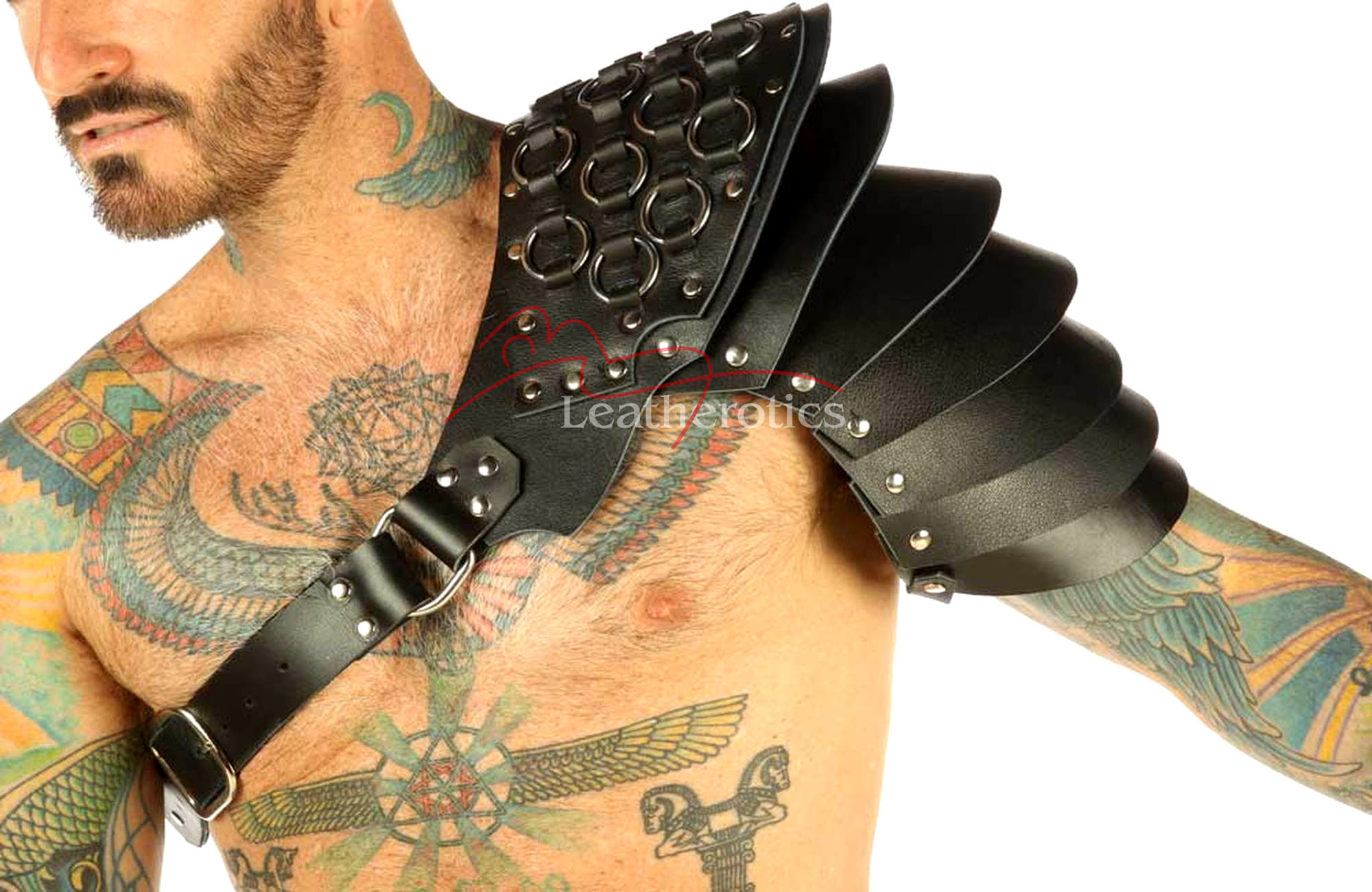
To make them more suitable for clothing animal skins & hides were treated with chemicals. Leather craft was becoming more about functions & visual appearances. Further down the line the development of leather became a predominant staple in everyone’s life. Accessories such as gloves, jackets, & more became largely available over the course of time. Leather craft progressed into a full-fledged industry. There were international consumers who were thrilled to buy and make use of leather goods & a global supply chain for the raw materials.
Tanning is a term used to define the process of transforming animal skin into leather, it undergoes a chemical treatment which consists of leather being soaked in a liquid containing tannic acid, or from the use of other chemicals. This then converts putrescible skin to a reasonably balanced stable which is a non-decayable material. The tanning agents which are widely used are vegetable tannin, mineral salts, & animal oil or fish.
Using raw animal hides & tanning them into leather are two very different things. The procedure of learning to make leather took place throughout multiple cultures around the globe over thousands of years.
It is thought that early man discovered tanning of leather through a mix of accidental discoveries. Humans noticed hides drying near smoke from their fire, this lasted longer than hides in other locations, skins that were dried by the sun did not rot the same way untreated skins did. When animal skins were found lying in puddles of rotting leaves & bark most likely from the oak trees, they were found to have cured & stopped decaying. Once they learned how to tan the untreated hides & prevent them from becoming hard & rot away, they then knew how to produce leather which was long lasting & flexible material. Once in a balanced state early man was able to soften hides by using oils & fatty substances & rubbing them into the rawhides which then enabled use of clothing, footwear, weapons & weather proofing.
Further on in time, early man became more sophisticated in his methods. Knowledge grew & as more time passed humans realised that scraping away excess flesh & fat, could refine leather. During these discoveries man developed a process known as liming, which consisted of taking the ash from fires & making up a solution which treats efforts to remove the hair from skins The accurate process by which humans worked out the mechanics & methods of leather tanning is somewhat lost to history however, we do know is that over time people around the globe have discovered advanced, new & novel ways to convert raw animal hides into durable leather goods, & these goods helped change the world.
Evidence suggests that some sort of early tanning process existed as far back as 100,000 years ago. Bone awls used to pierce soft materials have been found and dated to be roughly 80,000 years old. There’s also evidence from around the planet that palaeolithic humans hunted fur-bearing animals, likely not for food but for their hides. Assyrian texts from the fifth millennium B.C, Contain leather tanning instructions, & by the rise of Roman civilisation leather tanning techniques were well developed & highly specialised. The earliest extant leather artefacts we’ve found date to around 2,200 B.C. Leather tanning in the ancient world remained largely unchanged until the industrial revolution, when faster, chemical-based tanning methods were developed.
Leather throughout the ages
Early ancestors started the process of developing leather from more than 7000 years ago with simple techniques. These techniques consisted of sun drying & providing salt to preserve the hides & skins of animals. It’s a testimony to human inventiveness, early ancestors were able to take the raw animal skins & transform them into something so durable & resourceful that leather has lasted for thousands of years.
The Egyptians discovered several uses for leather & there are hieroglyphs & artefacts furthering back to 5000 BC to prove this. These artefacts demonstrate & reveal the great skilfulness that the Egyptians had when it arrived at the process of vegetable tanning the leather, applying uses such as drying & curing techniques, which allowed them to mould & employ the leather for sandals, military equipment & even burial shrouds.
The ancient Greeks are known for leading leather to the forefront. Multiple varieties of leather sandals were produced to suit every occasion, which was astonishing. The most famous reference to leather during this period is featured in ‘Homer's Odyssey’. The story of which a leather bag filled with storm winds was given to Odysseus which was provided by the gods of winds. This was to help him reach Ithaca. Homer obviously thought highly of the capability & durability of leather material as it withstands great forces.
The Romans embraced leather as the go-to material for military uniforms, as well as saddles & shields which were for horses. The sandals worn by brigades had the responsibility to endure wear for hundreds of miles as they had to march on foot, into the next battles. Roman sites which were excavated found unearthed tannery in Pompei & several articles of leather shoes, clothing, and Vellum (produced for bookbinding) in England. No Roman soldier was properly attired without his leather uniform.
Continuing into the Middle Ages it was the Arabs in parts of Spain who brought leather to the next level by designing highly desirable leathers such as the Cordovan. This type of leather was used to create shields & military breastplates, but it was the use of leather in bookbinding which had the biggest value & effect. Leather-bound books contained vital, immense knowledge & stories which were then passed into Europe through trade with the moors. The Arabs decorated leather beautifully with flowers & symbols using specialist tools to create stunning patterns.
During the 19th Century, the Europeans trail-blazed & industrialised the leather making process. It was elaborated & used for wall coverings, furniture & eventually cars. A modern method of applying chemical Chromium salt during the production of the leather resulted in suppleness & softness. The vegetable tanning processes previously used, allowed for mass production & caused traffic for demand in leather for homes, furniture, shoes & clothing.
History of leather in the stone age (prehistory - 3000 BC)
The stone age is one of the longest periods in history, it extends over millions of years, however we begin to see the works of leather & the birth of leather craft develop around 400,000 years ago. Stone tool is a tool which is made of stone, entirely or partially. Stone tools are associated with prehistoric cultures. The earliest stone tools date back to around 3.3 million years ago, flakes of stone which generally had sharp edges, were made useful for cutting, carving & scarping. These stone flakes could have been used to skin hides from animals & scrape them clean in the beginning processes of tanning leather, though it isn’t until around 400,000 BC that we start to see evidence of more leather tools.
First leather tools:
Stone scarping tools were found in modern day Hoxne, England. When experts examined the tools through microscopic wear patterns, they were able to identify & conclude that the stone tools were likely used specifically in scraping hides, this scarping would help them prepare for the next steps of the process such as tanning & use.
Bone tools originated from Africa, about 1.5 million years ago, which was when they were first used. Bone awls which were used as leather punches in sewing hides, which were made from a wide variety of bones. E.g., an ulna of deer, could be cut then polished to form a sharp tip. The awls were likely to be used to pierce the hides of leather materials. This way leather hides could be joined together to create larger clothes & spacious shelter coverages.
Leather culture (sex/BDSM)
Leather was the dominant practise & discussion of gay BDSM from the late 1950s all the way up to the 80s. Leather culture was tied to gay individuals & gay communities since that’s where it was birthed & first discovered, however leather culture has widely opened to, lesbians, trans & straight people since then.
Leather cultures implement styles & designs organised around sexual activities & sexual purposes which involve leather garments such as vests, boots, jackets, chaps, harnesses, bondage masks, & other items. Many individuals associate leather culture with BDSM (bondage/discipline & Dominance/submission, sado/masochism, also referred to as ‘SM’ & S&M) activities. Wearing black leather clothing is an erotic, sexy fashion which expresses & signifies intense masculinity, femininity regarding sexual power. Leather is a material widely used for multiple productions but has developed a topic in sexual context.
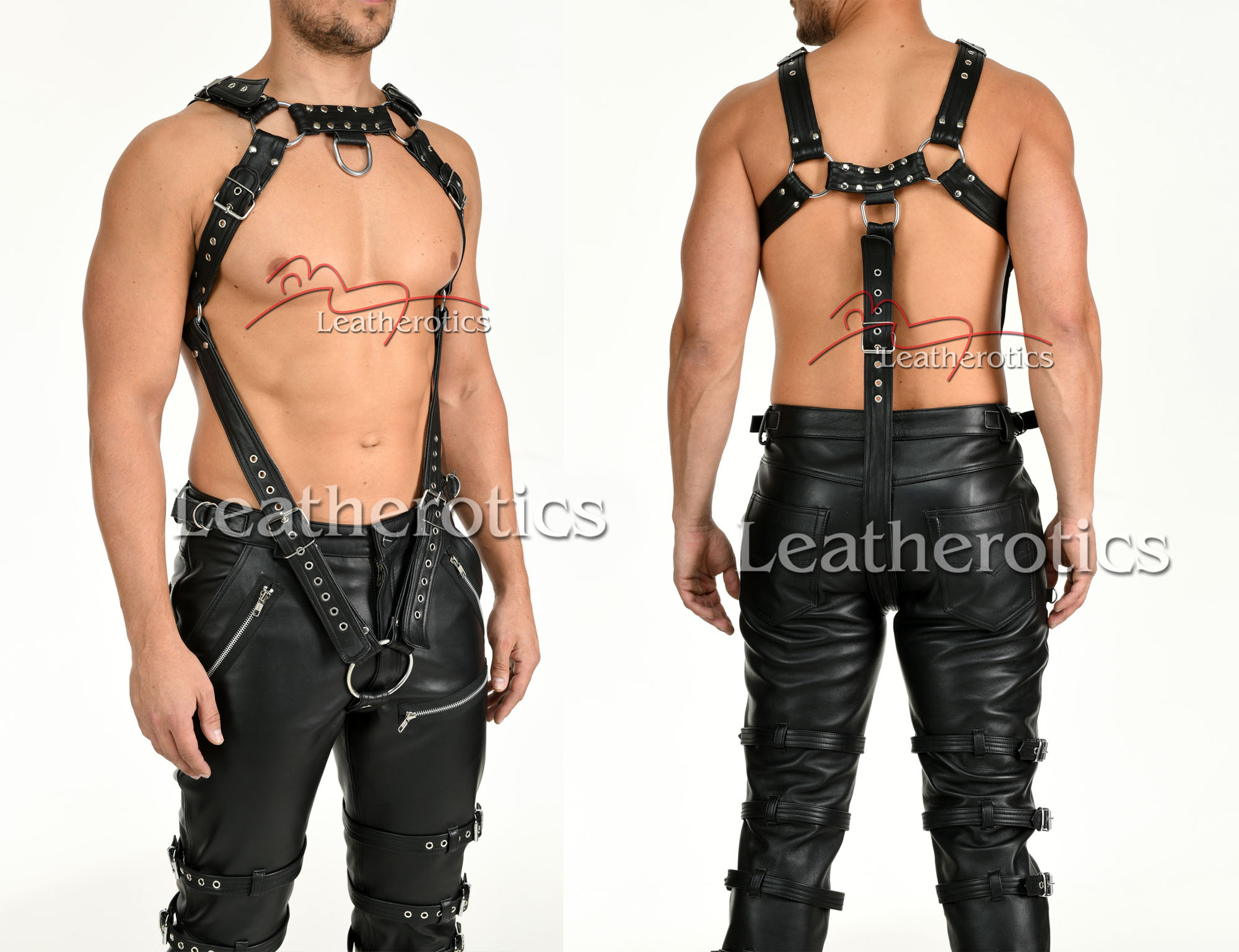
Leather is affiliated with sex because of its primal, masculine fabric. It's worn tightly & is super restrictive. It can also be physically used as sex props e.g a leather whip, which can be effectively used for sexual pleasures, it enables usage such as teasing & tickling the skin softly & gently or causing pain if its brought down hard. It doesn’t have to be worn & can be used for all sorts of fun & experiments.
We usually associate & picture dominatrix with pain, pleasure, whipping & wearing leather head to toe. Leather has a strong place in kinky communities. People into bondage or BDSM have used leather restraints or leather props. Kinky garments & fetish leather clothing such as, bondage masks, sexy leather dresses, tight lacing corsets & more were also introduced. The leather within these communities & cultures are considered sexually arousing, but this also allows those individuals to identify each other. Rather than just wearing a leather jacket, people in leather cultures often are seen wearing harnesses or characteristic/distinctive clothing items.

Fetish leather clothing for many people has become the icon of sex, which is kinky, erotic, masculine, feminine & provocative, regardless of sexual orientation. Fetish leather clothing can be found easily on a BDSM online shop. Looking to buy BDSM items? We at Leatherotics have you covered! We have multiple items ranging from full grain bondage masks to leather erotic underwear, all from top quality. Ensuring you purchase with confidence & satisfaction. Fetish leather clothing right at your door!

How to style Leather
Every woman knows that the coolest, chic, trendy, & must-have clothing item is, of course, the ultimate leather jacket. We usually associate & link this type of jacket with fashionable, trendy modern-day women; however, it’s fascinating history showcases a different side. Did you know that the leather jacket originated & appeared for the first time during the First World War? Yes, it’s very much true! In the year of 1918 German pilots used the classic, ultimate leather jacket as a protection of their military uniform. Soon, it transformed into a worldwide trend thanks to the first leather motorcycle jacket sold by ‘Harley Davidson’. This was inspired through the history of military uniforms. Now in today’s modern world its more fashionable then ever. This item is versatile, extraordinary & cool which presents a certain intriguing flair about someone when worn.
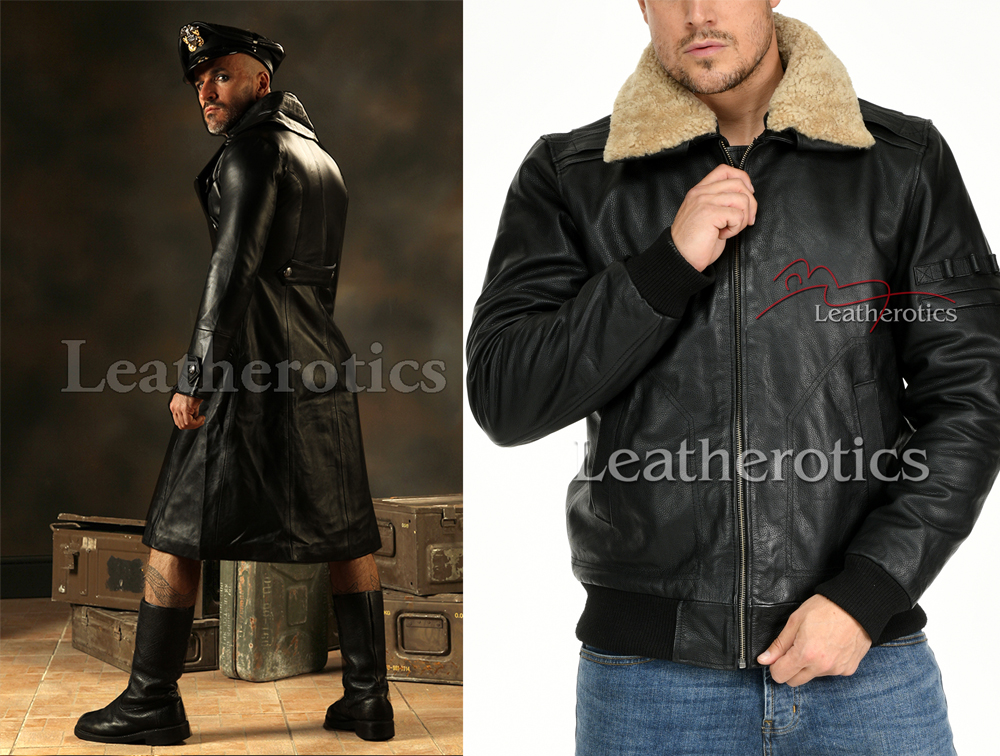
From wars to catwalks…
There is something about leather when worn which no other material brings. It portrays a sense of class, strength, coolness & sexiness. It can be both masculine & feminine, when worn it certainly stands out even in black… never failing to be the most eye-catching garment piece out of an entire outfit. It places a sense of uniqueness about a person. The material can be displayed through men’s leather jeans, sexy leather dresses, real leather catsuits, tight lacing corsets, leather gothic clothing & even bondage masks, so now you can see how versatile this material can be, its limitless & unquestionably the most classic material ever introduced into society.
Here are a couple of ideas on how to style leather garments for every occasion.
Is finding that perfect outfit for lunch with the girls difficult? Well, don’t worry we have you covered. We can ensure you’ll turn up in style looking fashionable, cool & comfortable. Opt for a maxi dress with a floral, colourful pattern & combine it with a black crop leather jacket. Throw on your favourite white sneakers & you’re all set to go.

Don’t worry boys, we have you covered too. A great outfit you can try is men’s leather jeans, here at Leatherotics, a shop for leather clothing, we specialise in men’s leather jeans… so what are you waiting for? Grab your pair of mens leather jeans now. Thinking of a night out with the boys, we know just the outfit for you that will pop. Combine those full grain leather men’s soft supple jeans with a beautiful tight white long sleeve t-shirt, put on some leather suede black boots & don’t forget to accessorise with a gold or silver pendant around the neck. Try this classic, cool, masculine outfit & you're guaranteed to stand out amongst the crowd.
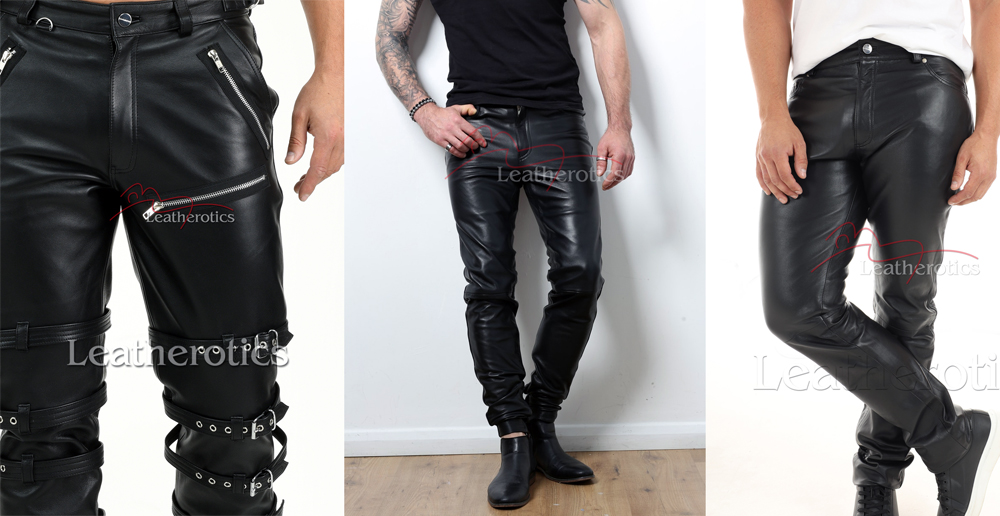
Heading for a night out with the girls? We got you covered here at Leatherotics, being a UK online shop for leather clothing, we sell tight fit leather skirts which will pair beautifully combined with a maroon or black sleeveless crop top. Whichever colour you choose to opt for, be sure to pair with fashionable, knee-high boots in either maroon or black. Combining a mini tight leather skirt with knee high boots will make you look sensational. Don’t forget to accessorise with leather bracelets & a gold plated necklace. You will look sexy & amazing for sure.
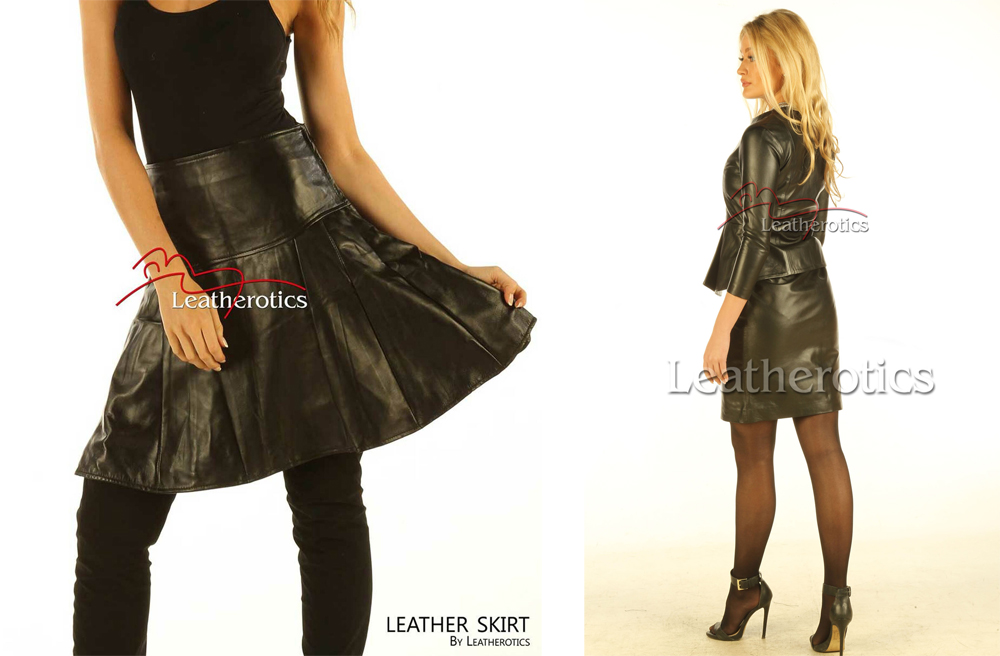 Heading to work? Well tight fit leather skirts can be so versatile, increasing your options, making your choices endless. Replace the common, boring blazer & express your personality. Investing in a pair of tight fit leather skirts here at Leatherotics will guarantee you shine in any setting. Complete your office wear with a tight fit leather pencil skirt. For this particular case, you can opt for a silk white button blouse. Tuck the blouse into the tight fit leather skirt to present sophistication, finish off with a pair of low classic black heels. This outfit is both sexy & professional.
Heading to work? Well tight fit leather skirts can be so versatile, increasing your options, making your choices endless. Replace the common, boring blazer & express your personality. Investing in a pair of tight fit leather skirts here at Leatherotics will guarantee you shine in any setting. Complete your office wear with a tight fit leather pencil skirt. For this particular case, you can opt for a silk white button blouse. Tuck the blouse into the tight fit leather skirt to present sophistication, finish off with a pair of low classic black heels. This outfit is both sexy & professional.
ooking to spice up your love life? Well tight lacing corsets will compliment you well & you can purchase one right from here at Leatherotics. If you’re looking for a bold, sexy, erotic, hypnotising outfit then this is unquestionably the one for you! Not only will it make you feel powerful, strong & sexy, but it will set the mood & deliver hot results! Corsets are not only for sexually appealing purposes, but it can be used as a foundation garment.
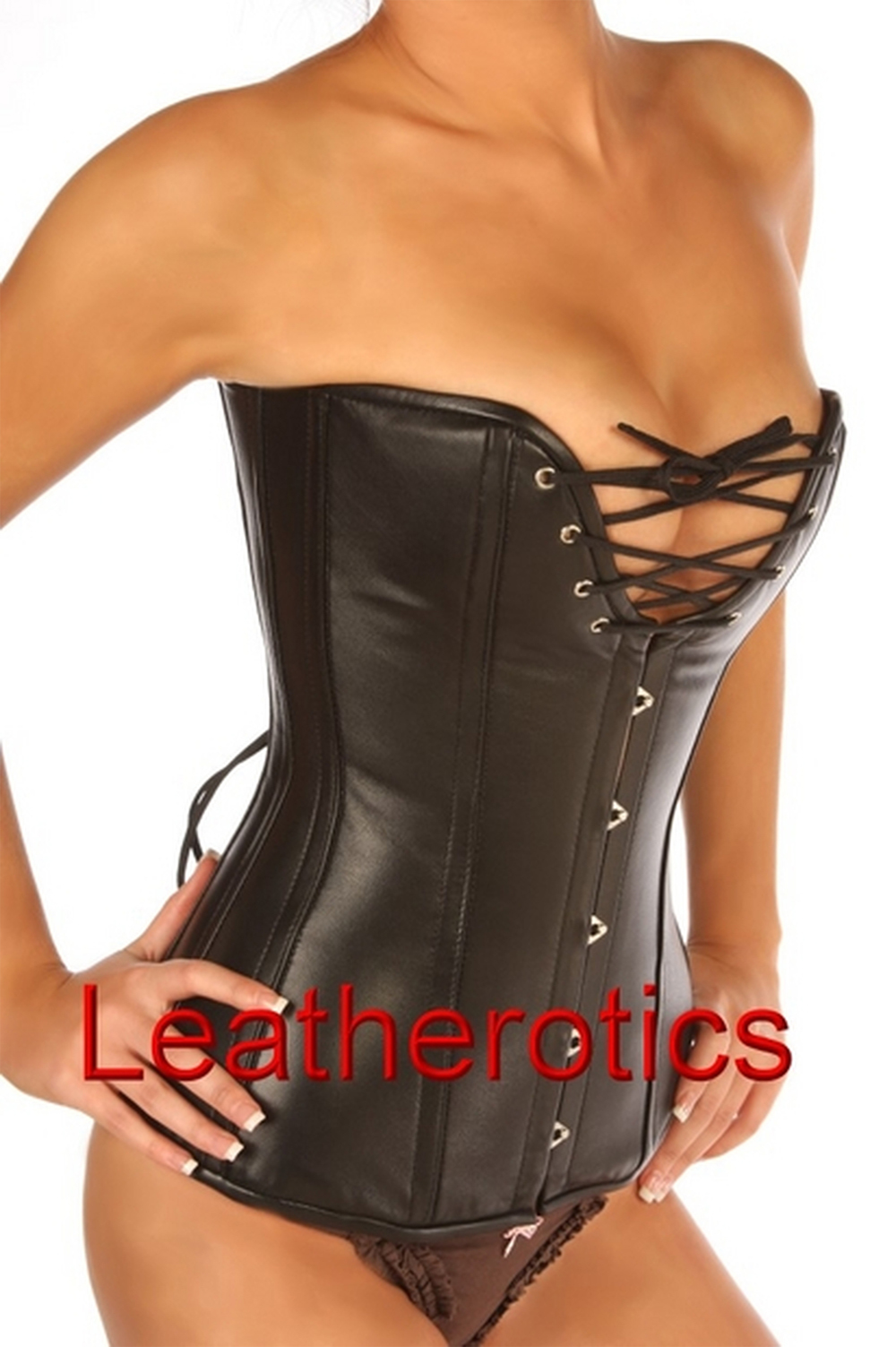
Those were just a few tips on how to style leather clothing, we only just scratched the surface with styling, since leather is so versatile. You can be endlessly creative with your leather garments & let your imagination run wild. From inspiring to being inspired… your options & styles with leather are never-ending.
Leather Tanning Methods:
Understanding the processes
Leather is a man-made product, so the quality of the fabric you buy will depend on which techniques & methods were used to process the leather. Some of the processing techniques include:
Natural tanning – Finding animals that had been preserved in bogs, likely inspired our ancestors to discover existing ways to achieve the same outcome from the animal hides.
Vegetable tanning – Creates a harder leather using natural plant extracts
Chrome tanning – Leather produced using this method is supple & waterproof so it can be applied to a variety of methods.
Glutaraldehyde/white tanning – This process is considered more environmentally friendly as it does not depend on heavy metals during the tanning process.
- Vegetable-Tanned Leather
Vegetable tanning method is one the oldest, traditional, methods of leather tanning & tolerated as one of the dominant forms of tanning for centuries. It is believed that the ancient Egyptians first began using this method over 5000 years ago as a way of protecting the animal hides. Approximately 10% of all leather is vegetable tanned.
The first step of the method consists of pre-tanning. Hair fat, residue & wool are removed through a process called ‘liming which involves soaking the drums in larger drums of chemical substances which are natural, known as ‘lime’. In order to lower the hides pH level another solution is applied to prepare it for tanning. This method is usually time consuming & requires a highly craftsperson which includes soaking hides in large baths of concentrated tannins over a course of several months, as the hides will absorb more vegetable tanning agents & more advanced physical properties. Once the tanning process is complete the hides then undergo dyeing & drying which consist of the damp hides being removed & oiled with conditioners & waxers to enhance the colour & improve durability, then it gets dried & staked which enables the leather to soften. Finishing touches involve the hide being sprayed with sealant for protection, its then trimmed, measured, & stretched, preparing it for the transformation of leather goods. This process creates a supple, strong, brown-tinted leather.
- Chrome-Tanned Leather
The vegetable tanning structure remained mostly unaltered for thousands of years until 1858, when chrome-tanned leather was invented by the German technologist Fredrich Knapp & Hylten Cavalin. This new system of chrome tanning became vaster & more dominant & generally used. A solution of chemicals, acids, & salts were used for chrome tanning to tan the hide, it is less time consuming then vegetable tanning which takes only about a day to produce a piece of tanned leather. Chrome tanning is a lot more efficient compared to traditional tanning methods which can take between a month & three months. First the hide is ‘limed’ then ‘pickled’ in the acid salt mixture which then gets placed in the chromium sulphate. All the hides then come out looking light blue known as “wet blue”.. Chrome-tanned leather is more supple than vegetable-tanned leather & isn’t nearly receptive towards water damage. Today it’s the most common leather tanning method used in modern production, with 80-90% of leather being tanned through a chrome tanning process. In 2008 around 24 million of chromium was produced.
- Hybrid chrome tanning compared to standard chrome tanning.
It has become increasingly required to produce safer chrome leathers in a sustainable fashion. Innovative hybrid chrome tanning uses a combination of chrome salts & Blancotan CAT which enables the customer to produce a new environmentally friendly ‘wet blue’. advantages of hybrid chrome tanning instead of standard is that it has a very low environmental impact, high percent of Cr2O3 is fixed to the leather fibres, uniform & excellent fulness of leathers, chrome free sludges, extremely light wet blue colours of leather, & leather with more performance dying properties compared to standard wet blue.
It’s important to know when buying leather goods or in a shop for leather clothing, that you are gaining the best value for your money & that the quality lives up to your expectations.
Quality ranges of leather
The thickness of the leather required will depend on what is going to be made up from it. Usually, quality leather makers will buy the thickness they require straight from the tannery rather than try to split it after purchase. The split leather is also sold by the tannery as Top Grain leather.
- Full Grain Leather - Provides the highest quality. Although it’s more expensive
Full grain leather is characterised as the best leather. Its natural surface is incredibly unique due to its marks & imperfections. It’s known for its luxurious, smooth surface & its strength. It is categorised as the most popular leather & absorbs moisture & oil. This type of leather has not been sanded, buffed, or snuffed in order to remove any natural marks or blemishes from the surface. This makes its fibres remain durable because its fibres have not been eliminated, unlike top grain leather which has its imperfections removed from its surface. Full grain leather does not wear out easily in fact it has a layer of patina, which defines a thin layer that protects the leather from damage or from wearing. It also develops a lovely patina over time which looks better the longer the item ages. This type of leather is used for making high premium quality footwear or furniture. This is the best leather available known for its maximum strength & resiliency.
- Top Grain Leather
Top grain leather is the second highest grade & the second highest in leather quality. It is more flexible & thinner due to its layer being separated; the outermost layer of the hide has been removed which makes it more pliable & thinner for manufacturers to work with. Both full grain & top grain are made from the best quality part of the hide. The leather's natural surface is sanded away in order to remove imperfections & blemishes. This can result in the hide losing some of its strongest fibres, however this provides a more uniform & smoother appearance. Top grain is applied with a finishing coat which provides protection against stains. It also develops pinna which protects it from corrosion & damage making it durable & last longer. It is less expensive than full grain leather & it has better stain resistance than full grain. Oils & waters do not absorb through top grain leather therefore it can be wiped away since the natural pores of the leather have been sealed during the colouring process.
- Corrected Grain Leather
Corrected grain leather is leather that has been sanded & buffed in order to remove its imperfections from the hide, such as scars from the surface or any visible effects, then an artificial grain can then be imprinted on the leather. Corrected grain leather can be categorised as any leather which has been altered, such as appearance that is not natural to the original hide. This can mean the top layer of leather can be completely buffed off, then be added with an artificial grain. This type of leather is considered just as durable as full grain however the buffing process which results in the surface being completely removed can also remove the surface's natural softness, meanwhile the patina won’t appear on corrected grain leather like it does beautifully with full grain.
The surface of corrected grain leather is removed in the exact way top grain leather is produced, both cases are similar & require buffing out the scars & blemishes on the hide, but to a greater depth. This is done to correct & remove major imperfections. Corrected grain has a large variety of looks, colours can vary depending on the type of dye & finish used, it has aesthetic qualities & is produced to create pigmented leather.
There is no consistent look for corrected leather however in order to identify if its corrected grain, try scratching it lightly & see if it leaves a mark. If there is no scratch mark visible, then it’s likely to be corrected grain. This leather is widely used around the world & is commonly used for handbags, jackets, bags, footwear, accessories & furniture.
- Split Suede Leather
Suede is a high-quality structured leather, which is created from the underside of an animal hide, its created from separating its underside of the animal hide from the top, this means that suede is a ‘split leather,’ since it’s been split from its original layers which are known to be tougher & less flexible. A more commonly used method is where the leather is split & the upper grain is removed to reveal only the fuzzy, napped underside which will result in becoming more visible on both sides of the material, sueded on both sides. This method creates results of the suede being more pliable & producing greater softness. The ‘nap’ of the fabric which are tiny, raised hairs sitting on the surface can be tougher if the hide comes from older animals such as cows & deer’s, these animals of which have thicker hides. Suede leather can be produced by almost any animal hide however the most common being lamb, deer, pig & calf. The texture of suede is usually smoother when it comes from younger animals. Suede is most definitely popular due to its luxurious smooth feel.
Humans have been utilising animal hides for clothing & accessories for thousands of years, yet the production of suede is somewhat recent. The term suede originates from “Gants de suede” which in translation means “gloves of Sweden”. In the late 18th century during the romantic period in France, importation of Swedish leather was incredibly popular among French noblemen. Artisans of Sweden invented a way & decided to use the soft inner skin, instead of the rough leather made from outer layers of the hide, to create incredibly soft gloves for women. For many decades the use of suede was limited & used for only gloves but eventually, European artisans identified & recognised other possibilities for other uses of suede, then greater wider collections of suede were being produced to make items such as shoes, bags, jackets & more.
Suede gives an elegant appearance & when it's dyed it can obtain more colour which results in a production of richer, deeper colours, plus the ‘napped’ texture generates more depth & variation which is one of the reasons it remains high end luxury. This type of leather can also be moulded easily because it's pliable, meaning it can create different interesting shapes, especially ones that wrap & hug the foot. It’s also versatile meaning it can be used for winter-based styles & summer-based designs. Due to its exceptional softness, it can give more comfort & softness on a wearer's foot, which makes styles crafted from suede generous in terms of softness & comfort. This material can be very long lasting when cared for properly
Leather will continue to play a key attribute & symbol in kinky organisations. Suede is often used in sexy industries to produce BDSM toys such as Floggers & whips. If placing items & objects directly onto skin, then full grain & bonded leather are most common & appropriate. BDSM toys can easily be found on a BDSM online shop where you can be able to discover more.
Bonded Leather
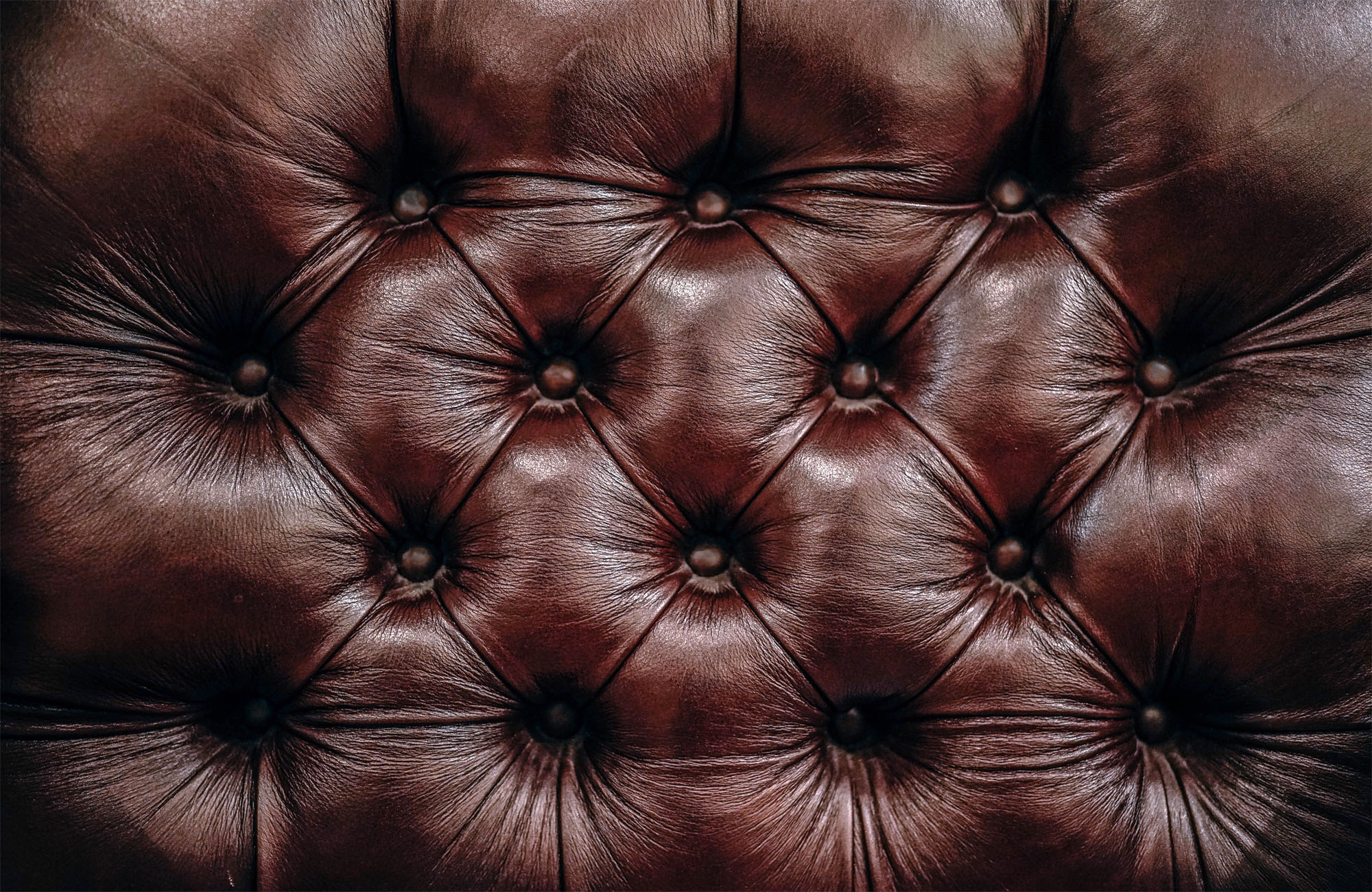
Bonded leather is made from the scraps of genuine leather. It’s a mix of both real & fake leather, it is made from the left-over scraps which are made to process genuine leather. These scraps of leather are mixed with a polyurethane binder, these fibres are then stuck together on a paper backing using adhesives to bond them. It’s coated with polyurethane & embossed to provide the appearance of genuine leather. Most bonded leather consists of 10-20% genuine leather.
The pro with bonding leather is that it's relatively cheaper than genuine leather due to its low percentage of real leather. This leather has a consistently smooth texture unlike genuine leather which has imperfections with its appearance. Bonding leather comes in all different designs & colour. Another pro is that Bonding leather can smell similar to genuine leather then an artificial leather
Its cons can be more over weighed. One being that its not as durable as genuine leather, second its easily prone to scratch/peel & can fade in sunlight due to low quality. Thirdly bonding leather can be hard to clean & it may also release some of the chemicals which were used when fibres were bonded together.
Bonded leather is easily mistaken for genuine leather & even manufacturers make the mistake of labelling bonding leather as genuine leather. Being able to segregate the differences & tell them apart will benefit & be helpful in future shopping for leather, especially when purchasing furniture.
The major key point & difference between bonded leather & genuine leather is the price. The cost of bonded leather will be significantly cheaper than genuine leather. Fake leathers are relatively cheap & low quality in material. Bonding leather can also give off that artificial feel & be thinner. It may smell like real leather however the real difference will showcase in how they look. This leather will have a consistent texture whilst genuine leather will have some imperfections.
Overall, the bottom line is that bonded leather is made up of scraps which makes it fake, cheap leather. The cons of this fabric certainly outweigh the pros. Due to the way bonding leather is made, it is prone to scratch, peel & flake over time. If you want furniture & clothing to last a long time, then real leather.
Benefits of Real Leather vs. Fake Leather: A Sustainable Comparison
- Durability and Longevity: Real leather products, sustainable leather, long-lasting leather
- Biodegradability: Biodegradable leather, eco-friendly material, natural decomposition
- Byproduct of the Meat Industry: Sustainable sourcing, ethical leather production, animal byproduct utilization
- Natural Material: Organic leather, chemical-free production, eco-conscious material
- Timeless and Versatile: Sustainable fashion choice, timeless appeal, long-lasting style
- Environmental Impact: Sustainable leather benefits, eco-friendly choice, reduced carbon footprint
- Resource Efficiency: Leather waste reduction, efficient use of animal hides, sustainable production
- Ethical Fashion: Sustainable leather products, cruelty-free material, ethical sourcing
- Slow Fashion: Sustainable alternative to fast fashion, conscious consumerism, long-term investment
- Eco-friendly Material: Environmentally friendly leather, green fashion choice, sustainable material

